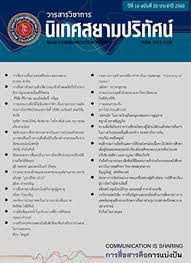The Relationship between Stakeholder’s Satisfaction on Crisis Communication and Corporrate Reputation of Financial Institution
Main Article Content
Abstract
This research has four objectives: 1. to survey stakeholder’s satisfaction on Siam Commercial Bank’s crisis communication, 2. to study the reputation of Siam Commercial Bank in crisis in stakeholder’s perspective, 3. to study the difference of satisfaction on Siam Commercial Bank’s crisis communication and corporate reputation among stakeholders, and 4. to study the relationship between stakeholder’s satisfaction on Siam Commercial Bank’s crisis communication and corporate reputation. The Qualitative Research method was employed. The data was collected from 400 stakeholders between 15-60 years old living in Bangkok. They were divided into two groups: customers and non-customers, 200 each. They knew Siam Commercial Bank and had background knowledge of the embezzlement case between King Mongkut’s Institute of Technology Ladkrabang (KMITL) and Siam Commercial Bank (SCB) and the case of the building’s malfunctioning fire security system led to multiple death. The findings show that both groups’ satisfaction on the Siam Commercial Bank’s crisis communication is in moderate level and that there were no differences among stakeholders. Furthermore, in aspect of Siam Commercial Bank’s reputation is in high level and that there were differences among stakeholders, those were Products and Services, Citizenship and Performance.
Article Details
References
กนก อมรปฏิพัทธ์. (2547). การสื่อสารแบบผสมผสานและชื่อเสียงขององค์กรที่มุ่งหวังกำไร องค์กรที่มิได้มุ่งหวังกำไร และองค์กรของรัฐ. (วิทยานิพนธ์นิเทศศาสตร์ดุษฎีบัณฑิต สาขาวิชานิเทศศาสตร์ คณะนิเทศศาสตร์. จุฬาลงกรณ์มหาวิทยาลัย.
รุ่งนภา พิตรปรีชา. (2553). ตัวชี้วัดชื่อเสียงของธุรกิจเอกชนในประเทศไทย. คณะนิเทศศาสตร์. จุฬาลงกรณ์มหาวิทยาลัย.
ภาษาอังกฤษ
Ali, I., Alvi, A.K., & Ali, R.R. (2012). Corporate reputation, consumer satisfaction and loyalty. Romanian Review of Social Sciences, 3. 13-23.
Barnett, M. L., Jermier, J. M., & Lafferty, B. A. (2006). Corporate reputation: The definitional landscape. Corporate Reputation Review, 9(1), 26-38.
Coombs, W. T. (2015). Ongoing Crisis Communication: Planning, Managing, and Responding: Planning, Managing, and Responding (4th Ed.). Thousand Oaks, California: SAGE.
Doorley, J., & Garcia, H. F. (2011). Reputation management: The key to successful public relations and corporate communication. Routledge.
Dowling, G. (2001). Creating Corporate Reputations: Identity, Image and Performance: Identity, Image and Performance. New York: Oxford University Press.
Fombrun, C. J. (1996). Reputation: Realizing Value from the Corporate Image. Harvard Business School Press, MA: Cambridge.
Fombrun, C. J. (2007). List of lists: A compilation of international corporate reputation ratings. Corporate Reputation Review, 10(2), 144-153.
Griffin, A. (2014). New strategies for reputation management: gaining control of issues, crises & corporate social responsibility. Kogan Page Publishers.
Griffin, R. J., Neuwirth, K., Dunwoody, S., & Giese, J. (2004). Information sufficiency and risk communication. Media Psychology, 6(1), 23-61.
Heath, R. L. (1994). Management of corporate communication: From interpersonal contacts to external affairs. Hillsdale, NJ: Lawrence Erlbaum Associates, Inc.
Kempner, M. W. (1995). Reputation management: How to handle the media during a crisis. Risk Management, 42(3), 4347.
Piriyakul, M., & Wingwon, B. (2013). Effect of corporate ability and reputation on organizations’ performance and CSR. African Journal of Business Management,7(9), 738.
Saffir, L., & Tarrant, J. (1993). Power public relations: how to get PR to work for you. Illinois: NTC Publishing.
Schuler, D. A., & Cording, M. (2006). A corporate social performance–corporate financial performance behavioral model for consumers. Academy of Management Review, 31(3), 540-558.
Solomon, M. R. (2015). Consumer behavior: Buying, having, and being. Engelwood Cliffs, NJ: prentice Hall.
Ulmer, R. R., Sellnow, T. L., & Seeger, M. W. (2015). Effective crisis communication: Moving from crisis to opportunity (3rd ed.). Thousand Oaks, Los Angeles: SAGE.
Wilcox, T. (2006). Human resource development as an element of corporate social responsibility. Asia Pacific Journal of Human Resources, 44(2), 184-196.


